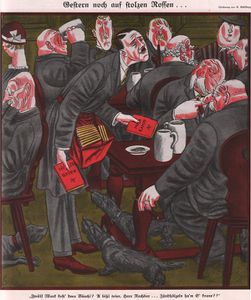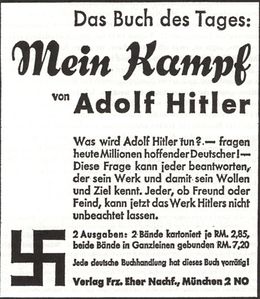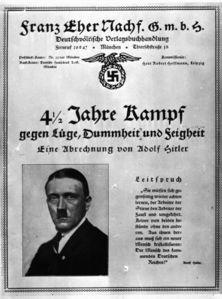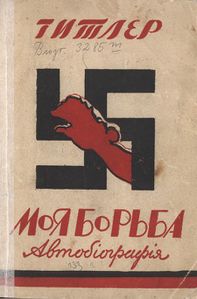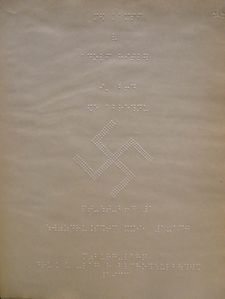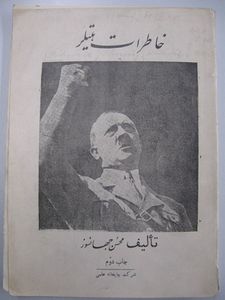Eberhard Jäckel und Ellen Latzin
Central programme of the National Socialist world view of Adolf Hitler (1889-1945). The first edition was published on 18 July 1925 (volume 1) and 11 December 1926 (volume 2) by Franz Eher Nachf. Verlag in Munich. By 1945, over 12.5 million copies had been sold or given away worldwide in 16 languages. After the end of the Nazi regime, the copyright to the book was held by the Bavarian Ministry of Finance for 70 years. The first comprehensively commented edition of "Mein Kampf" was published by the Institut für Zeitgeschichte (Institute of Contemporary History) in 2016.
History of Origins 1924/25
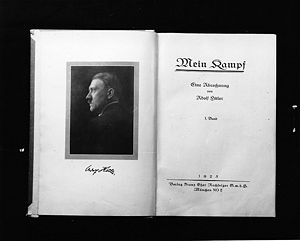
The book was written under the title "Viereinhalb Jahre Kampf gegen Lüge, Dummheit und Feigheit. Eine Abrechnung." (My Struggle. Four and a half years of struggle against lies, stupidity and cowardice. A Reckoning) in the Landsberg am Lech penal institution since July 1924. Adolf Hitler (1889-1945) served a prison sentence there after the failed attempted coup on 8/9 November 1923. Unlike previously discussed, he did not dictate the text to other people (Rudolf Heß [1894-1987] and Emil Maurice [1897-1972] were suspected) (Plöckinger, Geschichte eines Buchs, 121-153). After Hitler was released from prison on 20 December 1924, the text was reworked several times and split into two parts. Significant parts of the second volume were not written until 1926.
The first part of the book was published on 18 July 1925 under the new title "Mein Kampf. An account" (My struggle. A Reckoning) with an initial circulation of 10,000 copies at Franz Eher Nachf. Verlag in Munich, the NSDAP party publishing house headed by Max Amann (1891-1957). The printing was done by the Munich book trade company M. Müller & Sohn in Schellingstraße 39/41. The second volume with the title "Die Nationalsozialistische Bewegung" (The National Socialist Movement) was published by Eher Verlag on 11 December 1926 (1927).
"Mein Kampf" became the publishing house's most successful product, significantly improving its finances. The fate of the original manuscript, which Hitler possibly gave to Helene Bechstein (1876-1951), is unclear (Plöckinger, Geschichte eines Buchs, 153-157).
Hitler's "second book", which supplements the discussions of foreign policy in "Mein Kampf" in particular, was written in the summer of 1928. However, the manuscript remained unpublished during the National Socialist dictatorship. It entered the National Archives of the United States after the end of the war and only appeared as a commented edition in 1961.
Distribution
"Mein Kampf" was also available in a one-volume, unabridged popular edition (780 pages) for 8 Reichsmark since 1930; Eher Verlag had printed 1.5 million volumes by the end of 1933. The book was also distributed at marriages, as a book award at graduation or on admission to the NSDAP since the takeover of power. However, numerous municipalities and cities, including Munich and Nuremberg, refused to use "Mein Kampf" as a wedding present for a long time. In 1939 5 million copies had been published, by 1945 the book had reached a total circulation of about 12.5 million copies. Critical reviews in the foreign press after 1933, such as the Daily Telegraph or The Times, and critical books such as those by Irene Harand (1900-1975) (1935) and Manuel Humbert (1905-1979) (1936), did not affect distribution. It was also translated into 16 languages.
The rights for the American edition were granted to Houghton, Mifflin and Co, who published the first English abridged translation on 11 October 1933. Since 1945, the copyrights to the German edition have been held by the Free State of Bavaria, to whom the Allies had transferred the assets of Franz Eher Nachf. Verlag and Hitler after the end of the war. After 1945 the book therefore appeared in numerous translations, but no longer in German. Even though German President Theodor Heuss (1884-1963) already suggested an annotated edition in the 1950s (Maser, Kampf, 45), a complete critical edition was not published unitl 2016.
-
The publication of "Mein Kampf" was commented on in the "Simplicissimus" magazine with the caricature "Yesterday still on proud horses ...". Drawing by Erich Schilling. Fig. from: Simplicissimus 30 (1926), Issue 22 dated 31.8.1925, 313. (Bayerische Staatsbibliothek - Bavarian State Library, 2 Per. 18 pe-30,1)
-
Advertisement by Franz Eher Verlag for "Mein Kampf"; Völkischer Beobachter (South German Edition), no. 31 dated 31 January 1933 (p. 4), one day after the appointment of Adolf Hitler (1889-1945) as Reich Chancellor.
-
Advertising poster for Adolf Hitler's "Mein Kampf", 1925. (Bayerische Staatsbibliothek - Bavarian State Library, Bildarchiv hoff-6656)
-
"Mein Kampf" has also been published in foreign-language translations since 1933: Title page of the abridged Russian edition. "Moja bor'ba", Shanghai 1935. (Bayerische Staatsbibliothek - Bavarian State Library, Biogr. 3285 m)
-
Mein Kampf. Braille issue. Title page, Marburg 1933. (Bayerische Staatsbibliothek - Bavarian State Library, 2 38.44-1,1)
-
Hitler's memoirs. Free partial translation of "Mein Kampf" into the Persian language in Arabic script, Teheran 1938. (Bayerische Staatsbibliothek - Bavarian State Library, A.or. 95.743)
Revisions
Editorial revisions of the first volume were made by Joseph Stolzing-Cerny (1869-1942) and Ilse Pröhl (1900-1995), the later wife of Rudolf Heß. The second volume was revised by Rudolf Heß. (Cf. Plöckinger, Geschichte eines Buchs, 121-153). Numerous stylistic improvements smoothed out Hitler's style of speech in later editions, too.
The book also underwent some factual corrections. The content was only changed in 1930. It determined that the NSDAP's "Unterführer" would no longer be elected but would be appointed by the higher-ranking leader. Otherwise, the content of all subsequent editions remained unchanged.
Content
While the first volume allegedly describes Hitler's life and the second describes the development of the NSDAP, the book is also, as the preface states, intended to define Hitler's goals and teachings. In truth, the autobiographical information is largely false and incomplete. It merely serves as a means to derive Hitler's views, which only emerged after 1919, from his life. In the same vein, the party history recedes almost entirely behind programmatic statements in the second volume.
The book discusses all areas of politics, but in Chapter 4 of the first volume and in Chapters 13 and 14 of the second volume it describes with particular clarity a future German foreign policy programme. Its aim was first to form alliances with Italy and England and then to defeat France in a war in order to create the conditions to conquer living space for the German people in Eastern Europe and Soviet Russia.
The book also contains Hitler's anti-Jewish programme. While after 1919 he had initially only called for the "removal" of the Jews, usually referring to their emigration or expulsion from Germany, he now called for their killing, which had a significance for the whole world: "No nation removes this fist (of the relentless world Jew) from its throat other than by sword (...) Such a process, however, remains a bloody one." Hitler lamented that the German government had failed to "mercilessly exterminate" the Jews at the beginning of the First World War and claimed that the defeat would not have taken place if 12,000 or 15,000 of them had been "kept under poison gas" (chapters 14 and 15 of the second volume).
Significance
The significance of the book is controversial in historical research. While some believe that it served only as propaganda, others, especially in view of Hitler's later politics, already see the serious presentation of his goals in it in the 1920s. Despite its wide distribution, contemporaries paid little attention to the book as a whole. Valid figures, regarding the number of German readers, for instance, do not exist. In 2006, Othmar Plöckinger (born 1965) tried to refute the myth of the "unread bestseller" by thoroughly documenting the intensified reception of the book by political opponents and supporters of National Socialism since 1930. However, his theses met with scepticism among experts.
Critical Edition
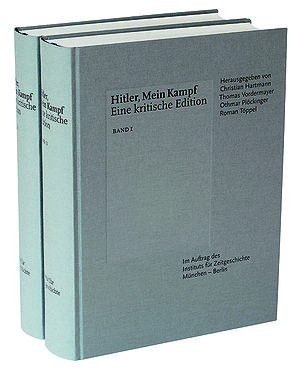
The copyrights to "Mein Kampf", which lay with the Free State of Bavaria after Hitler's death, expired at the beginning of 2016. The first comprehensively commented academic edition of "Mein Kampf" was published by the Institut für Zeitgeschichte on this occasion in 2016. The question as to whether the book that was central to Nazi ideology should be resold 70 years after the end of the dictatorship in Germany led to considerable public controversy, in the course of which the Bavarian State Ministry for Education and Culture, Science and the Arts withdrew partial funding for the project in consideration of the victims of National Socialist tyranny. Even after the publication of the edition, which sold a total of 85,000 copies by January 2017, the debate about how to deal with "Mein Kampf" continued; for example, the extent to which passages from it should be used in school lessons was discussed.
References
- Eberhard Jäckel, Hitlers Weltanschauung. Entwurf einer Herrschaft, Stuttgart 1983.
- Sven Felix Kellerhoff, "Mein Kampf". Die Karriere eines deutschen Buches, Stuttgart 2015.
- Karl Lange, Hitlers unbeachtete Maximen. "Mein Kampf" und die Öffentlichkeit, Stuttgart u. a. 4. erweiterte und überarbeitete Auflage 1991.
- Werner Maser, Adolf Hitlers Mein Kampf. Geschichte, Auszüge, Kommentare, Esslingen 11. Auflage 1981.
- Othmar Plöckinger, Geschichte eines Buches: Adolf Hitlers "Mein Kampf" 1922-1945, München 2006.
- Antoine Vitkine, Hitlers "Mein Kampf". Geschichte eines Buches. Aus dem Franz. v. Sabine Hedinger/Sabine Schneider/Christian Stonner, Hamburg 2015.
- Thomas Weber, Wie Adolf Hitler zum Nazi wurde. Vom unpolitischen Soldaten zum Autor von "Mein Kampf". Aus dem Engl. v. Heike Schlatterer/Karl Heinz Siber, Berlin 2016.
- Barbara Zehnpfennig, Hitlers Mein Kampf. Eine Interpretation, München 2000.
Sources
- Irene Harand, Sein Kampf. Antwort an Hitler, Wien 1935.
- Christian Hartmann u.a. (Hg.), Hitler, Mein Kampf. Eine kritische Edition. 2 Bände, München, Berlin 2016.
- Adolf Hitler, Mein Kampf. 2 Bände, München 1925/1927.
- Hitlers Zweites Buch. Ein Dokument aus dem Jahr 1928. Eingeleitet und kommentiert von Gerhard L. Weinberger, mit einem Geleitwort von Hans Rothfels (Quellen und Darstellungen zur Zeitgeschichte 7), Stuttgart 1961.
- Manuel Humbert, Adolf Hitlers "Mein Kampf". Dichtung und Wahrheit. Mit einem Vorwort von Heinrich Mann, Paris 1936.
- Eberhard Jäckel zs. mit Axel Kuhn (Hg.), Hitler. Sämtliche Aufzeichnungen 1905-1924, Stuttgart 1980.
- Othmar Plöckinger, Quellen und Dokumente zur Geschichte von "Mein Kampf" 1924-1945, Stuttgart 2016.
- Othmar Plöckinger (Hg.), Schlüsseldokumente zur internationalen Rezeption von "Mein Kampf", Stuttgart 2016.
Further research
External links
Related articles
- Beer Hall Putsch (Hitlerputsch), 8-9 November 1923
- Nationalsozialistische Deutsche Arbeiterpartei (NSDAP), 1920-1923/1925-1945
- Strafanstalt Landsberg am Lech
Alternative titles!
Cite
Eberhard Jäckel/Ellen Latzin, Mein Kampf (Adolf Hitler, 1925/26), published 11 May 2006, english version published 3 March 2020; in: Historisches Lexikon Bayerns, URL: <http://www.historisches-lexikon-bayerns.de/Lexikon/EN:Mein_Kampf_(Adolf_Hitler,_1925/26)> (20.12.2025)

